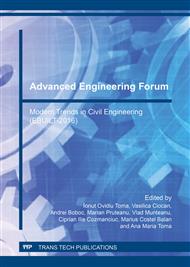p.45
p.50
p.58
p.65
p.73
p.78
p.86
p.94
p.102
STM Modelling Methods of Structural Discontinuities
Abstract:
This paper presents Strut and Tie Method (STM) general modelling principles of discontinuity zones of structural members. In order to increase the precision for determining the bearing capacity of reinforced concrete beam ends, the possibility of simultaneously using two complementary versions of STM modelling of these extremities, statically determinate, complying with Eurocode 2, is analysed. To highlight the precision and simplicity of simultaneously applying the two modelling versions a numerical analysis is carried out, where the methodology is presented in detail.
Info:
Periodical:
Pages:
73-77
Citation:
Online since:
March 2017
Authors:
Price:
Сopyright:
© 2017 Trans Tech Publications Ltd. All Rights Reserved
Share:
Citation:


